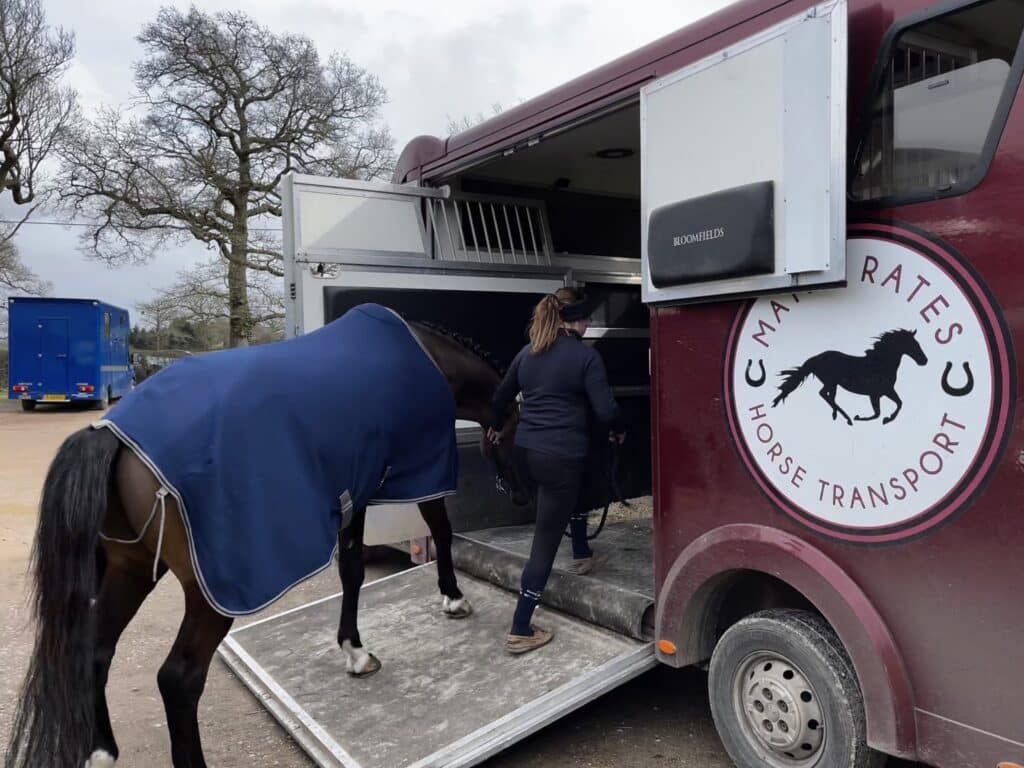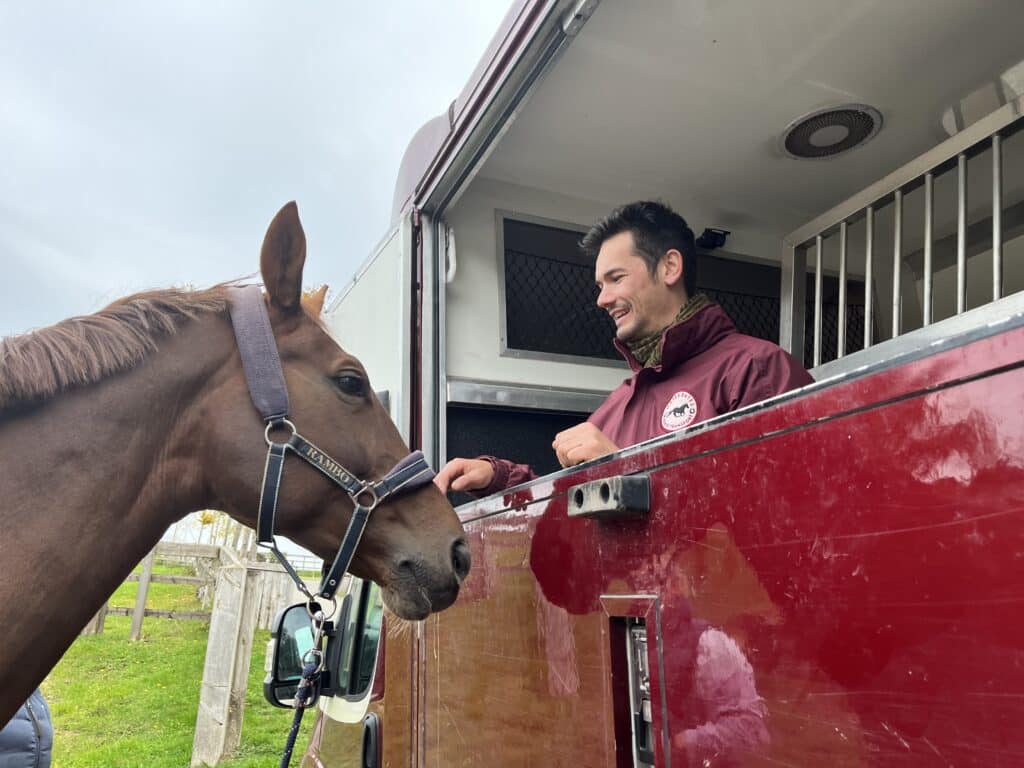Behaviour, Featured, Training and Management
Loading horses
Caroline Arnold, offers a holistic approach to the horses that say ‘no’ to loading
How do we load a horse? For most of us, we simply lead them up the ramp and pop them on the lorry – but what happens when that doesn’t work?
Based in Sussex, I have been transporting and loading horses for several years up and down the country and abroad with my business partner Justin. In that time, we have come across hundreds of different horses with various needs, anxieties, traumas and comprehension. When we come across a horse that won’t load, we want to break down the potential ‘why’. This comes under a few different categories.
The first possibility is trauma or injury related to travelling. Whether the horse has injured themselves while travelling or jumped the breast bar.
Next is if the horse is in physical pain or has been rehabilitated from an injury and associates travel with pain.
Then we have a horse who is claustrophobic. The claustrophobia can be as a direct result of a trauma experienced while travelling, or just that the horse has a pre-disposition to dislike small, enclosed spaces.
And finally, the horse who doesn’t understand how to load.

Building trust
Whatever the reason why the horse won’t load, we always start in the same way with educating them and helping them to trust us. We move their feet. We move their feet and connect with them on the ground away from the lorry. After some calm work with connection, we then introduce a simple pattern of a figure of 8. The figure of 8 pattern becomes a handy tool to go back to when either the horse needs to regulate themselves or when they’ve been struggling with the next stage of what we’re asking. We bring them back to where they feel confident and successful.
The most important thing to remember is that your horse must be in a calm position from the beginning to be able to successfully learn. Whatever the reason why they won’t load, we can push them out of their comfort zones at times, but they must be able to come down from their adrenalised state and out of flight mode or we will not see another positive step. This is so crucial to all horses. Each new stage that we introduce, we make sure that the previous stage is a safe space for them. If your horse tends to run off backwards and feels safer miles away from the lorry, start by helping them find calm near the ramp. And then introduce the ramp as the next point of calm. That way when they say “no thanks”, they don’t then run off around the carpark trying to get as far away from the lorry as possible. Their safe space to go back to is merely a step backwards in a calm, measured way. As we continue to work in this way, their “no” reset will get closer and closer to actually staying where they are and, still willing to listen to what we have to say next – why – because we’ve heard them and we acknowledge their anxiety.
“Autonomy is just as important for horses as it is for us”
I’m sure we’ve all been in situations where we’ve been told to push on, despite every nerve ending saying not to, it doesn’t often equate to a positive experience – even if we ultimately didn’t die. Instead of feeling like we’ve accomplished something, we might feel like we weren’t heard and that perhaps we won’t trust the people telling us to push on next time. Or perhaps we might avoid being in that situation entirely.
Understanding how to load
When a horse won’t load because they don’t understand how to load, we can break it down into segments. I liken this scenario to a complicated maths problem, then it becomes clearer to people why their horse doesn’t fully understand. If we imagine we are a child studying algebra and the teacher standing over us and saying “come on, do the maths” over and over again, we don’t then feel safe or heard when we say “I can’t do this”. Equally, if our teacher rushed us through to get to the answer, we might have vaguely understood how to get there, but under exam conditions, we find ourselves yet again, frozen to the spot.
So why not make loading a nice, supportive process for the horses who say “I don’t understand how to give you the answer”? Break each step down. Play across the ramp. Help your horse find calm at each step. Reward with space, time, patience, and softness in yourself. And most importantly, don’t overdo it. Have zero expectations as to how your loading practice will go and take every step forward as a win.

Broadly speaking, when we’re dealing with a horse that has any sort of trauma – whether it’s claustrophobia, pain memory or a negative experience, we start the same way – that is to find calm at every stage of the process. Sometimes this can be a relatively quick progression. But sometimes it can take a lot, lot longer. It very much depends on your pressures and expectations versus what your horse is comfortable doing at each step. The more we push our horses beyond their safe space, the less likely they are to want to trust us with the next step. Therefore, we work to the horse’s pace and set out to see what they want to give us in each session. We strongly believe in allowing autonomy during our loading practices. The more a horse feels seen and heard they will progress far quicker than if we try and rush them through at a pace that fits our desires.
What do we do to support horses that are anxious while travelling?
Again, we try to work out why. When we work with horses who have experienced trauma or are claustrophobic, we often start by taking the partitions away and allowing the horse to travel loose. This gives them space to find the position they are comfortable travelling in. Our box is roomy enough for most horses to comfortably turn around in, however we do tend to tie up the bigger horses who are a little more unbalanced, so they don’t get themselves stuck! By taking the partitions away, we allow the horse more autonomy. Our stallion box allows us to do this safely.
Your horse might feel anxious travelling, due to association with what happens at the other end – was it a trip to vet, or a new yard or owner? These are big, unnatural changes that we can’t explain to our horses and so they start to expect something negative every time they are presented with their mode of transport.
A final thought is to ask if the reason why your horse won’t load or shows anxiety while travelling is because they actually don’t like the direction of travel? I know we don’t all have the luxury of choice, but if your horse struggles to balance rear facing, does forward facing or herring-bone make a difference?
If you find your horse doesn’t load or travel well, remember it’s an entirely natural response by an animal that is intrinsically designed to be in big, open spaces within a herd. By working empathetically with your horse, loading challenges can become a distant memory.

